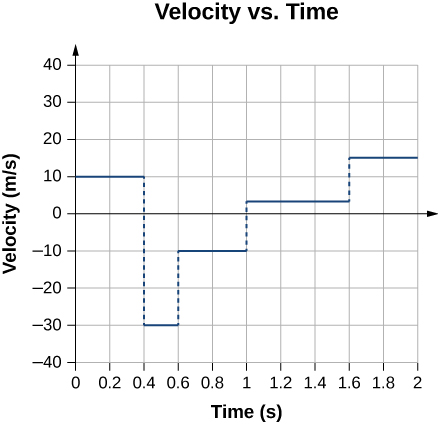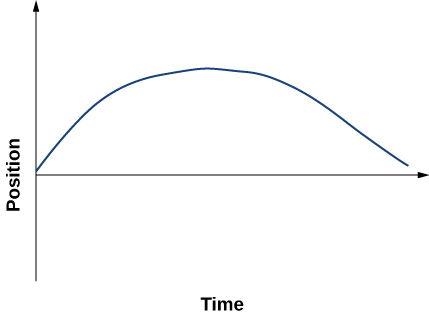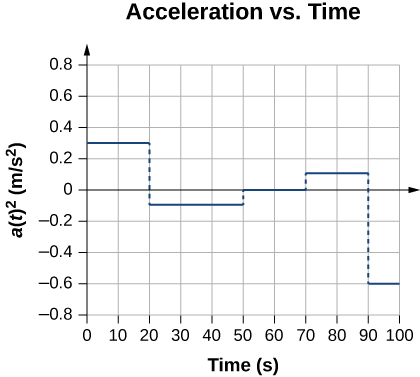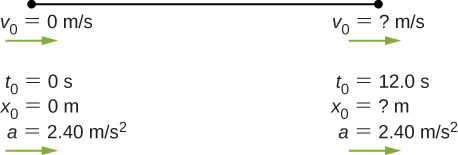Chapter 3
Check Your Understanding
(a) The rider’s displacement is . (The displacement is negative because we take east to be positive and west to be negative.) (b) The distance traveled is 3 km + 2 km = 5 km. (c) The magnitude of the displacement is 1 km.
(a) Taking the derivative of x(t) gives v(t) = −6t m/s. (b) No, because time can never be negative. (c) The velocity is v(1.0 s) = −6 m/s and the speed is .
If we take east to be positive, then the airplane has negative acceleration because it is accelerating toward the west. It is also acceleration opposite to the motion; its acceleration is opposite in direction to its velocity.
To answer this, choose an equation that allows us to solve for time t, given only a , v0 , and v:
Rearrange to solve for t:
- The velocity function is the integral of the acceleration function plus a constant of integration. By Equation 3.18,
Since v(0) = 0, we have C1 = 0; so,
- By Equation 3.19,
.
Since x(0) = 0, we have C2 = 0, and
- The velocity can be written as v(t) = 5t(1 – t), which equals zero at t = 0, and t = 1 s.
Conceptual Questions
If the bacteria are moving back and forth, then the displacements are canceling each other and the final displacement is small.
Average speed is the total distance traveled divided by the elapsed time. If you go for a walk, leaving and returning to your home, your average speed is a positive number. Since Average velocity = Displacement/Elapsed time, your average velocity is zero.
A ball is thrown into the air and its velocity is zero at the apex of the throw, but acceleration is not zero.
If the acceleration, time, and displacement are the knowns, and the initial and final velocities are the unknowns, then two kinematic equations must be solved simultaneously. Also if the final velocity, time, and displacement are the knowns then two kinematic equations must be solved for the initial velocity and acceleration.
Problems
a.
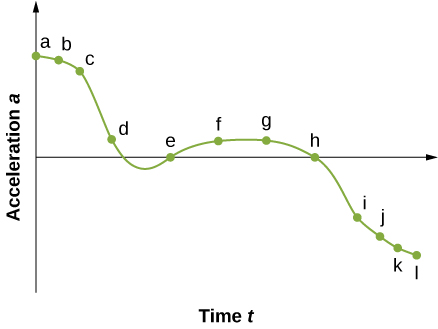
b. The acceleration has the greatest positive value at
c. The acceleration is zero at
d. The acceleration is negative at
a. ;
b. ;
c. , because the assumption of constant acceleration is not valid for a dragster. A dragster changes gears and would have a greater acceleration in first gear than second gear than third gear, and so on. The acceleration would be greatest at the beginning, so it would not be accelerating at during the last few meters, but substantially less, and the final velocity would be less than .
a. ; b. to the apex times 2 to the board = 0.82 s from the board to the water , solution to quadratic equation gives 1.13 s; c.
Time to the apex: times 2 equals 2.24 s to a height of 2.20 m. To 1.80 m in height is an additional 0.40 m. .
Take the positive root, so the time to go the additional 0.4 m is 0.04 s. Total time is .
Additional Problems
Equation for the speeding car: This car has a constant velocity, which is the average velocity, and is not accelerating, so use the equation for displacement with :; Equation for the police car: This car is accelerating, so use the equation for displacement with and , since the police car starts from rest: ; Now we have an equation of motion for each car with a common parameter, which can be eliminated to find the solution. In this case, we solve for . Step 1, eliminating : ; Step 2, solving for : . The speeding car has a constant velocity of 40 m/s, which is its average velocity. The acceleration of the police car is 4 m/s2. Evaluating t, the time for the police car to reach the speeding car, we have .
At this acceleration she comes to a full stop in , but the distance covered is , which is less than the distance she is away from the finish line, so she never finishes the race.
, h = total height and time to drop to ground
in t – 1 seconds it drops 2/3h
or
t = 5.45 s and h = 145.5 m. Other root is less than 1 s. Check for t = 4.45 s m
Challenge Problems
a. ;
b. ; c. The slope of the position function is zero or the velocity is zero. There are two possible solutions: t = 0, which gives x = 0, or t = 10.0/12.0 = 0.83 s, which gives x = 1.16 m. The second answer is the correct choice; d. 0.83 s (e) 1.16 m
, 295.38 km/h = 82.05 m/s, time to accelerate to maximum speed
distance covered during acceleration
at a constant speed
so total time is .
